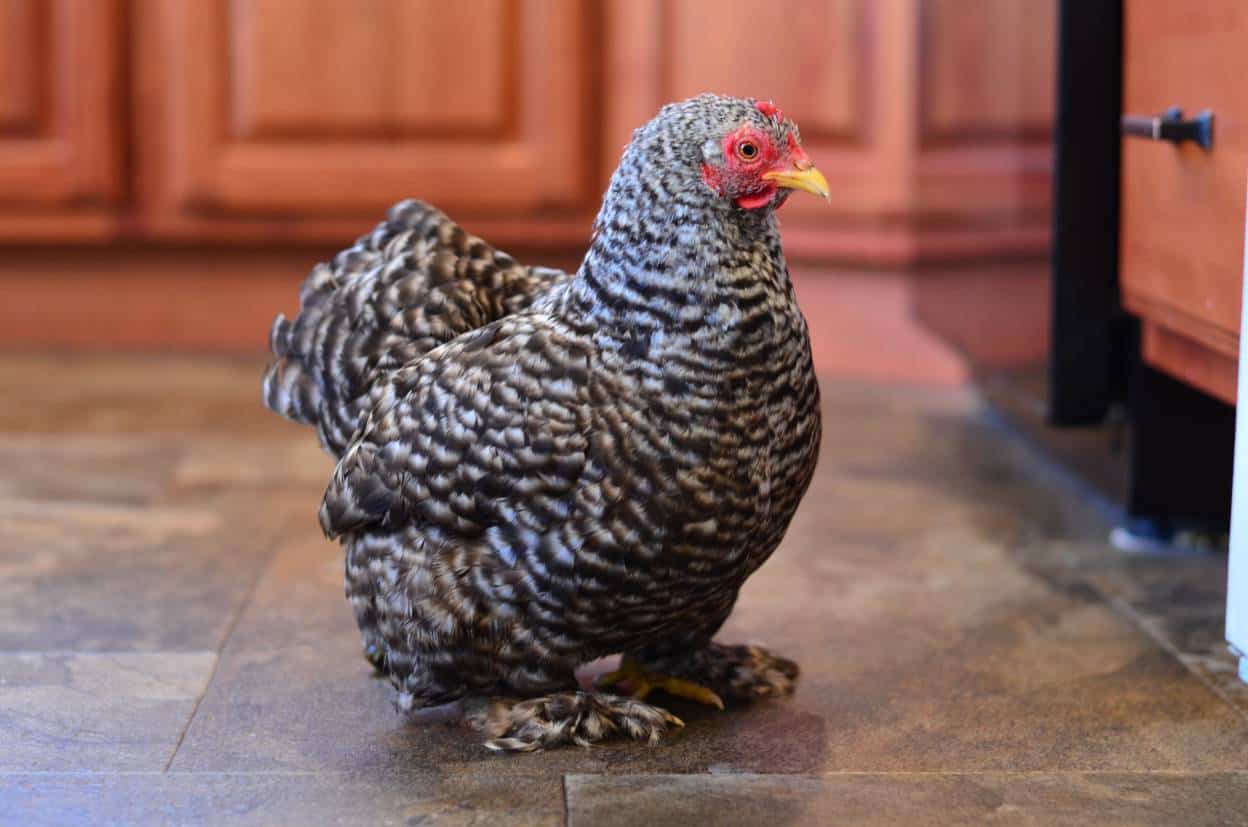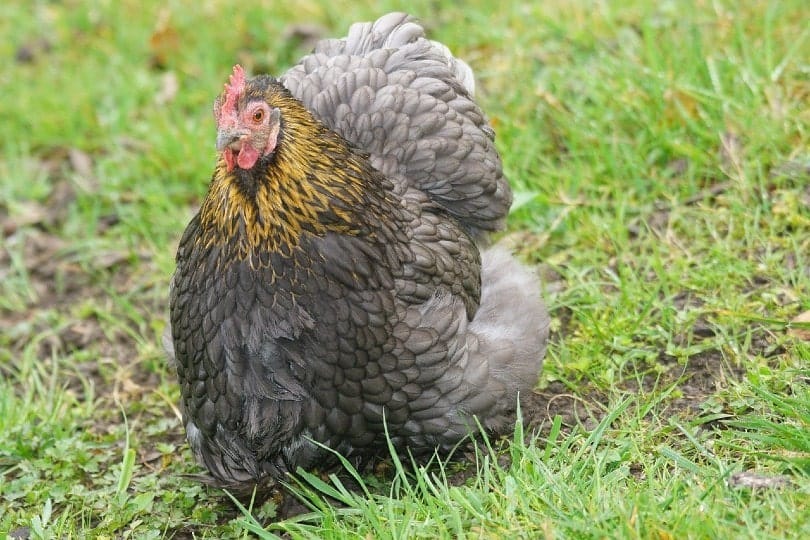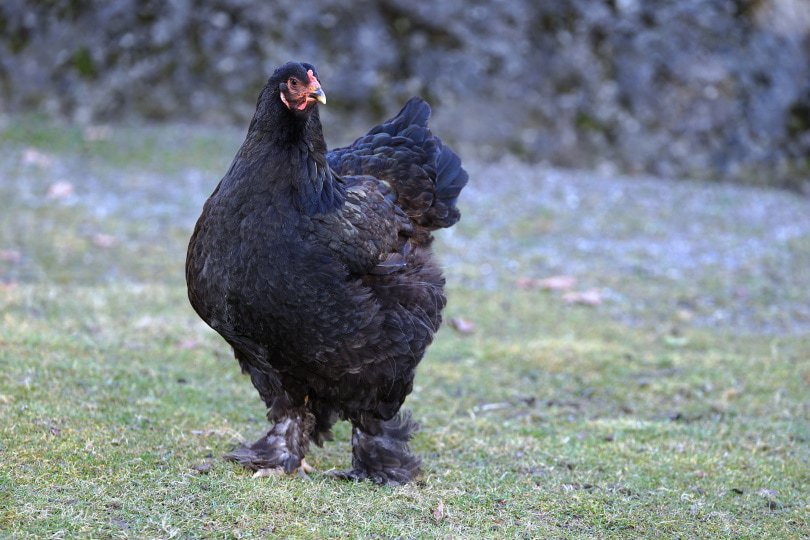The lovely Cochin chicken is a remarkable sight to behold. This breed has been around for centuries and is highly revered in the poultry community. While this breed is technically ornamental, meaning they are kept for appearance, they still have many uses for any flock—mainly their wonderful brooding potential and superb motherly instincts.
These feathery, fluffed-up beauties have personality and looks on their side. Find out if the Cochin chicken sounds like a good fit for your small-scale farm. We think that you will very much appreciate everything they have to offer. Let’s check it out!

Quick Facts About Cochin Chickens
| Breed Name: | Cochin |
| Place of Origin: | China |
| Uses: | Exhibition |
| Rooster Size: | 11 pounds |
| Hen Size: | 8.5 pounds |
| Color: | Varied |
| Lifespan: | 5-8 years |
| Climate Tolerance: | Cold-hardy, heat-sensitive |
| Care Level: | Moderate |
| Production: | 100 eggs annually |
| Temperament: | Docile, calm |

Cochin Chicken Origins
When the Cochin came about, they really caused a hen-fever frenzy among the masses. This breed originated in China from other feather-legged fowl, touting weighted bodies with plump proportions.
The Cochin was developed in the Shanghai province in 1840 and took off in popularity after that. Only about ten years later, the Cochin made its way across England and the United States, where it became a prevalent backyard breed.
Along with the Brahma, Cochins contributed to the “hen fever” era. Known initially as Shanghai birds and later as Cochin China birds, they were featured only a few years after developing in the Standard of Excellence in Exhibition Poultry.
The bantam variation was recognized by 1864 along with the full size by the American Poultry Association.
These birds were so popular that they even enjoyed lifetimes in royal gardens. Thanks to the fact that they astonished keepers (for a good reason), we can still enjoy Cochin chickens in their full glory today.

Cochin Chicken Characteristics
Many people who own a flock of chickens will recommend a Cochin to anyone. These birds have beautiful temperaments that set them apart from more active or aggressive breeds to the very friendliest.
While having a variety of layers can definitely serve a purpose in both entertainment and function, it’s nice to have the one chicken that you can go pick up and carry around with you.
Calm & Docile
The Cochin chicken is well known for being incredibly calm and docile with handlers, even roosters. They are more slow-paced than some other breeds, lacking vigorous activity or foraging skills. This lackadaisical chicken is perfect for small children, 4H Projects, or to have as a pet.
Easily Confined
Because of their docile nature and low activity, they do very well in confinement. If you have a small, enclosed coop and want to raise a flock of chickens who don’t mind the inability to forage, this is definitely a breed to consider.
Dual-Purpose Chickens
Likewise, if you are looking for a buddy over an immaculate layer or meat chicken, they very well could meet your expectations. Even though the Cochin is relatively easy to care for, they can be quite finicky about their environment, depending on your geographical location.
These big gals love to eat. If you give them enough sustenance, they won’t bug anyone. They are perfectly content snacking all day long on whatever goodies they can find. It seems they have to pack on the pounds to fill out those feathers.

Uses
Because of Cochin’s temperament and appearance, they are mainly kept for exhibition purposes. However, they have quite a bit to offer in the coop as well.
Egg Laying
These birds are incredibly broody, taking in orphan chicks and even sitting on duck and turkey eggs, hatching them with high success. Their overall broodiness makes them an excellent addition to your farmyard, even if the eggs you wish to hatch aren’t their own.
Cochins themselves lay large brown eggs and have a steady schedule even in the winter months. This is an excellent trait because when your other hens start to slow in the winter months, you can count on consistent laying from your Cochins. Annually, these birds lay roughly 100 eggs.
Collecting any of the eggs in your coop might be the tricky part. Cochins, because of their broodiness, are slightly territorial when they’re feeling motherly. You have to commend them, they really love raising babies. And they don’t want anyone to get in their way while they’re trying to do that.
You might notice a Cochin ruffle up its feathers and make absurd noises at you to deter you from touching their eggs or baby chicks. However, despite their broodiness, they are not known to attack or be aggressive towards others.
Meat
While you can use the Cochin for a meat chicken, most would recommend you don’t. These chickens tend to be a little tough and extremely dark. However, if they are butchered by around 12 months of age, they can make a sizable table bird.
So ultimately, it all comes down to preference of flavor. While some might not enjoy the texture or taste, some others might enjoy it very much. It’s simply not as tender or savory as some other flock mates.
Appearance & Varieties
Cochin chickens have quite a presence. They have very large bodies with full feathering from their heads all the way down to their talons.
They are one of the chicken breeds that have incredible feathering around their legs where other chickens are bare. They have such thick feathering that they only have two naked toes at the bottom, and everything else is covered up with their impressive fluffy presentation.
Both cocks and hens are full and soft feathered, lacking the tight feathering of some other barnyard chickens like Australorps or Rhode Island Reds.
Because of specialized breeding, they come in various colors that are both beautiful and versatile. You can find Cochin chickens in the following colorations:
- Barred
- Black
- Blue
- Brown
- Buff
- Golden-laced
- Partridge
- Silver-laced
- White
The bantam breeds are available in the exact same colors along with four other selections, which include:
- Birchen
- Columbian
- Mottled
- Red
Instead of having iridescent feathering like some chickens, the colors tend to be a bit diluted looking, creating an interesting fade that adds to the visual appeal.
Cochin chickens have both bantam and standard varieties. Both look nearly identical in structure, just not in size. Some prefer bantam chickens due to their compact design. While some bantams might be a little frisky, the Cochin is not among them.
And don’t let the fact that bantams are typically more active deter you from selecting the smaller variety. The bantam Cochin chickens are equally broody and make absolutely excellent mothers of both adopted chicks and their own creations.
Population/Distribution/Habitat
Cochin chickens are incredibly widespread poultry. They are typically a favorite among many different cultures for their overall compatibility.
Because of their award-winning and wonderful temperaments, they have won over hearts everywhere. You can find Cochin chickens on nearly every continent, although much less near the equator due to heat sensitivity.
Habitat
As mentioned earlier in the article, these chickens do incredibly well in confinement. If you have a small setup that is completely fenced in, that will be just fine with your birds. They aren’t wanderers or impressive foragers, as they much prefer free, effortless meals from handlers.
However, all chickens are happy to free-range if given permission. If you do allow free ranging, you might find that these slow-paced chickens love to meander around your property without a care in the world. Since they are so broody, they need a nesting space at all times otherwise they might be forced to create their own outside of the coop.
Do be careful because when they go broody, they rarely let up. So, if you find that your chicken has laid eggs outside of the coop, you might have to physically return her and the eggs to a safe place. This disruption could cause her to reject the eggs she’s been sitting on.
Heat Warning
Because of their thick tufts of feathers from their head to their talons, they keep very warm in colder climates. As a result, they are a perfect breed to have if you live in northern parts of the world. Nonetheless, if you live in hotter climates, take heed.
Cochins are not a heat-tolerant species. If the area you live often has toasty summers that go well into the 90s F, you have to take some serious measures to keep them cool or avoid the breed altogether, as they can suffer immensely and even die in the heat.
If you do live in a more tropical climate, keeping these beauties is still possible. Here is a really useful little blurb by a Cochin keeper who lives in hotter temperatures.
They recommend keeping Cochins in a place where they can cool off in the sand, soil, or another form of turned-up earth. They need lots of shade and access to cold water—preferably needing several refreshers throughout the day.
Also, if your hen is laying on a clutch of eggs, you need to make sure that she is incredibly comfortable in the coop so she doesn’t overheat. Broody hens rarely leave their eggs for eating or drinking, so making sure the environment is cool and suitable is absolutely necessary for your hen’s health and the developing chicks.

Are Cochin Chickens Good for Small-Scale Farming?
If you don’t mind that the Cochin is not a master layer or perfect meat producer, you will love the breed. They are extremely gentle and motherly, making them incredible if you want to hatch your chicks.
What makes the Cochin the most ideal candidate for small-scale farming is the breed’s adaptability to lack of space. These chickens do not mind being in smaller enclosed areas, permitting they have snacks and a good pile of eggs to sit on.
Related bird reads:
Featured Image Credit: Dewi Cahyaningrum, Shutterstock
